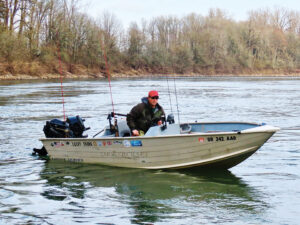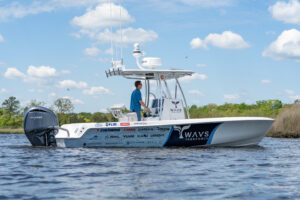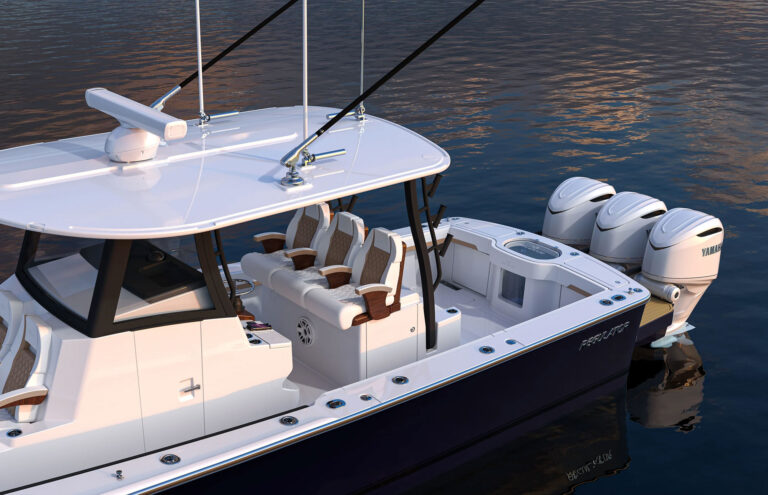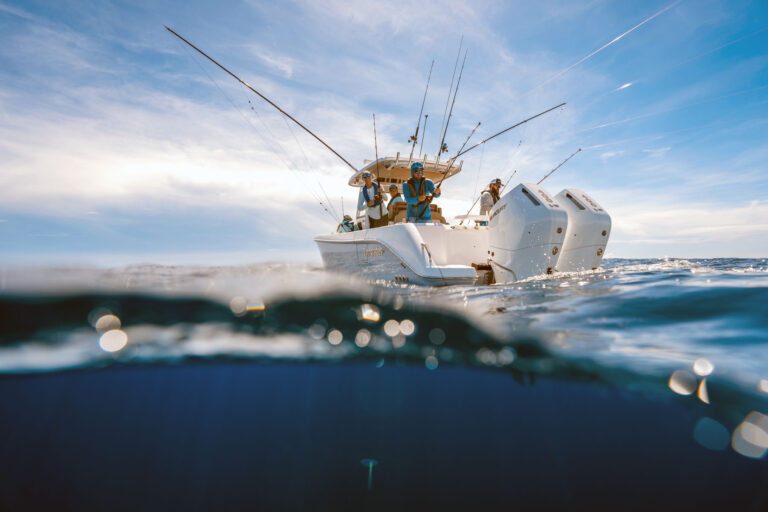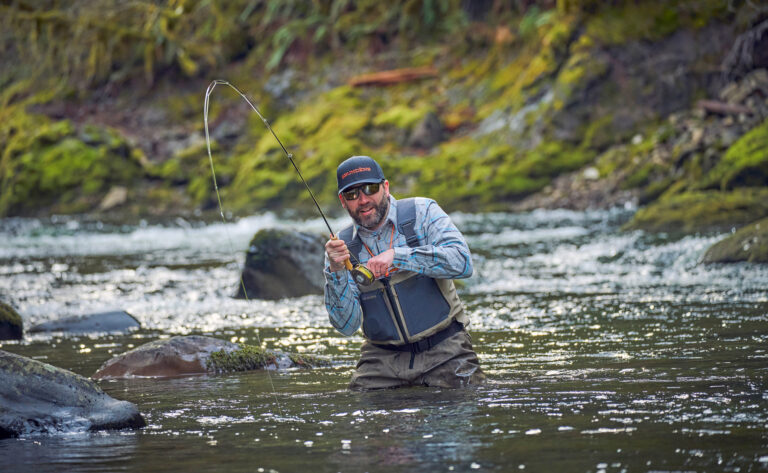 Merritt’s Boat & Engine Works this year celebrated the family’s 100th year of boatbuilding.
Merritt’s Boat & Engine Works this year celebrated the family’s 100th year of boatbuilding.Merritt’s Boat & Engine Works this year celebrated the family’s 100th year of boatbuilding, a tradition that began at the start of World War I when Roy Merritt’s grandfather went to work at the Norfolk Naval Shipyard as a carpenter building oceangoing merchant marine vessels. By 1929 the family was living in Florida, where Franklin LeRoy Merritt built his first sportfisherman for charter off Fort Lauderdale. This was the 38-foot Caliban with which his son Allen would win his first of eight Cat Cay Tuna Tournaments.
Merritt got its start in Pompano Beach, Florida, in 1948 when F. Roy and Ennis Merritt bought 8 marshy acres on the Intracoastal Waterway for a boatyard to service the boats owned by sons Buddy and Allen as well as those of other charter captains. A ship’s carpenter, the old man rarely used his skills for anything but remodels, and there were more than enough of those to keep him busy. Had it not been for a tenacious customer who kept after F. Roy to build him a boat, Merritt might never have started a boatbuilding business.
Capt. Buddy Merritt, F. Roy’s oldest son, is widely credited with the Merritt boat’s distinctive design and styling, but his father was the one who laid up the yard’s first hull in 1954. It’s no secret the concept for that carvel-planked 34-footer was inspired by Norseman and Rybovich & Sons’ first boat, Miss Chevy II, launched in 1947. Built for $16,000 for a Fort Lauderdale developer, the Merritt-built Miss Bel-Air had a styling all her own thanks to Lee Woolard, a designer and builder who had worked for Norseman in Miami. The flybridge, console and deckhouse were an homage to Rybovich, but instead of Rybovich’s broken sheer, Woolard gave Miss Bel-Air a straight sheer that 60 years later is a timeless Merritt trademark.
This was the boat on which Buddy Merritt learned his craft as a builder. As the story goes, halfway through construction F. Roy asked his son to work at the yard, which had grown so quickly neither he nor Ennis could handle the workload. Buddy agreed, but only if he could work on new boats and stay out of the service business. Three years later, Buddy designed and built his idea of what a true tuna fishing boat should be. The Merritt 37-foot sportfisherman is widely regarded as the finest ever built for taking giant tuna in the Bahamas.

Buddy wanted a boat ideally suited to the demands of giant tuna fishing. Compared to a Rybovich, it had the unbroken sheer that was ultra-modern for the time, as well as a bigger cockpit and flybridge. Yet the biggest difference lay below the waterline. Though it can ride rough in a head sea because of its deep entry and flatter aft sections — more a function of the boat’s size than a design defect, Allen says — the 37 was the fastest and most maneuverable boat in the tuna fleet. And it kicked up a minimal wake at speed, which was key to presenting baits to wary tuna. Hull design, along with the mechanical rack-and-pinion steering systems developed by Merritt machinist Carl Feddern, gave the boat its sports-car handling, which one captain describes as “turning on a dime while giving you 9 cents change.”
Buddy Merritt, who died from Lou Gehrig’s disease in 1971, was responsible for 18 of the 103 new boats Merritt’s Boat & Engine Works has built over the last 60 years. Thirteen of his builds were 37s.
Under Buddy’s direction, few compromises were allowed during construction. The boats were Spartan to keep them light and fast. That meant no air conditioning, no plush saloon or galley, and no generators for living aboard. Creature comforts consisted of two crew’s bunks, a day head and cushions on the engine boxes. Yet veteran captains such as Clay Kyle were more than willing to put up with the lack of appointments. “It was long and narrow with hard chines and nothing but two engines and a chair, so it ran like hell. It was the first good tuna fishing boat,” says Kyle.
When Buddy liked something, he stuck with it, says Roy Merritt, Allen’s son and the company’s current boatbuilder and CEO. “Buddy really liked the 37, which is why he almost said no to Fletch Creamer in 1964 when he asked him to build him something bigger for traveling and living aboard.”
The yard’s shipwright at the time was Len Broadhurst, designer/builder of Elwood Harry’s Dreamgirl, which was skippered by Capt. Walter Voss. Dreamgirl was recognized as one of the best sea boats around, so when Broadhurst offered to use his plans for the 42-foot Dreamgirl, Buddy agreed to build Creamer a 42-footer.
At the time, Creamer’s 42-foot Hopalong was the biggest boat the yard had ever built. “She was a nimble 32-knot fishing machine,” says Capt. Bart Miller, who later purchased the boat and shipped it to Kona, where as Black Bart it caught a 1,656-pound Pacific blue marlin. Although it ran great, it was not the prettiest Merritt ever built, says Roy. “Buddy thought the house was too big for the hull. The owner, however, had wanted as much house as possible, so we built what Creamer wanted but never again,” adds Roy, who by this time was working full time at the yard after graduating from high school.
By 1957, Allen was managing the yard’s service department. With no charter boat at his disposal, he and son Roy would go snapper fishing on a workboat. One night they talked about buying a hull and finishing it off as a personal fishing boat. “Dad was interested in a 42-foot commercial lobster hull until Len Broadhurst talked him out of buying it. Len didn’t think it was well-suited to fishing at anchor because it had a round bottom and suggested using the patterns for the Hopalong and finessing them,” remembers Roy.
 Merritt’s Boat & Engine Works this year celebrated the family’s 100th year of boatbuilding
Merritt’s Boat & Engine Works this year celebrated the family’s 100th year of boatbuildingOver the next two-and-a-half years, the 23-year-old Roy and Broadhurst worked on the project three nights a week and Saturdays. “I had a hand in every aspect of its construction, from planning and design to personally cutting every piece of framing and wood that went into it,” says Roy. As for the boat’s lines — that ended up being a bit of luck, he confides. “I modified the cabin patterns from the Hopalong, streamlining them for a more pleasing appearance.”
During the building, Buddy often stopped by to check on progress and even helped plank the boat. But it wasn’t until it was launched in 1968 and Buddy saw the boat running that he decided he wouldn’t mind having one for himself. By this time Buddy had been diagnosed with incurable amyotrophic lateral sclerosis, or Lou Gehrig’s disease. The yard worked overtime to complete Buddy’s 42-footer so he could take it to Newfoundland to fish for giant tuna in 1969. During that trip, anglers Elwood Harry, George Matthews and Gil Keech, along with Buddy and his sons Richard and Stephen, and mates Gary Stuve and Charlie Hayden, caught 16 giants in a day, setting a record that stood for more than 30 years.
When Buddy died two years later, he passed the baton to his 29-year-old nephew Roy, who has successfully steered the company ever since. Quiet and unassuming, Roy worked in his uncle’s shadow the first few years. Yet the 42 that stretched in 1975 to 43 feet, with an even more streamlined deckhouse (as Jo Jo Del Guercio’s No Problem), was his baby — as are all of the models launched since. The line runs to 86 feet now.
Admired by Pat Healey of Viking Yachts and other boatbuilders as one of the nation’s top custom builders, Roy Merritt has made his own contributions to the sport and to the comfort of big-game sportfishing boats, designing and building the first hardback fiberglass bucket harness for clients in the 1970s after one complained about ropes eating into his hips. “The guy said, ‘Can’t we do something to make it stiffer?’ ” Roy recalls. “I suggested we build it from fiberglass, and after making a prototype in the shop we upholstered it and took it to Cat Cay for a test run. It worked great. We turned the manufacturing over to Capt. Fred Stone, who built them for several years.”
And when Del Guercio tossed out an idea for a multiple-rod holder for light-tackle sailfishing in the Florida Keys, Merritt created the “rocket launcher,” a name coined by Merritt machinist Feddern, who after making the first prototype out of pipe decided it looked like a bottle launcher.

To boatbuilders like North Carolina’s John Bayliss, Roy Merritt’s greatest contribution to the industry is the modern-day mezzanine. After hearing John Fossil’s complaints of discomfort from sitting on hard tackle lockers while fishing on a blustering spring day off Walker’s Cay, Roy took a napkin and sketched a lounge with seating and an oversized hardtop with built-in heating and cooling for the 70-footer he was building for Fossil. The mezzanine got a lukewarm response back in 1994 when it made its debut. “We all raised our eyebrows when we saw it, thinking that will never work,” recalls Bayliss. “Ten years later, you won’t find a large sportfisherman without one. That all started with Roy.”
Merritt has been influential in the trend of building larger sportfishing yachts, as well. “When Roy Merritt started building big sportfishing boats that perform as nimbly as something two-thirds their size, he showed us there is a market for big sportfishers,” says Bayliss.
Merritt says the availability of higher-horsepower engines, coupled with customers’ desire to go faster and farther, influenced his decision to build boats 80 feet and over after years of building up to 46 feet, then 60- and 62-footers such as Tyson’s Pride, which went around the world fishing on its own bottom. “That boat opened a lot of people’s eyes. The next step was 72 feet and now 86,” says Roy.

With encouragement from mentors such as the late Jim Smith, Merritt was in the vanguard of builders who pressed ahead from traditional plank-on-frame to cold-molded, fiberglass and composite glass-and-core construction, which he first used in 1979 to build the foredeck and cabin sides of the 46. Today, a Merritt boat is built mainly of composites. More than 80 percent of its 86-foot sportfishing yachts are built of carbon-fiber materials and epoxies for greater weight-to-strength ratios and longevity.
Arguably more a yacht than a pure fishing machine, the 86-footer is surprisingly fuel-efficient and nimble for its size. In testing, its top-end performance was clocked at 38 knots.
“At Merritt we have a cradle-to-grave philosophy about the boats we build,” Roy says. “We design and build them, insure and service them, and when it comes time to sell, we try to find good owners and crews to take care of them. We build the boats to last. Our plan is to stay in business forever.”
Bad news for fish.


